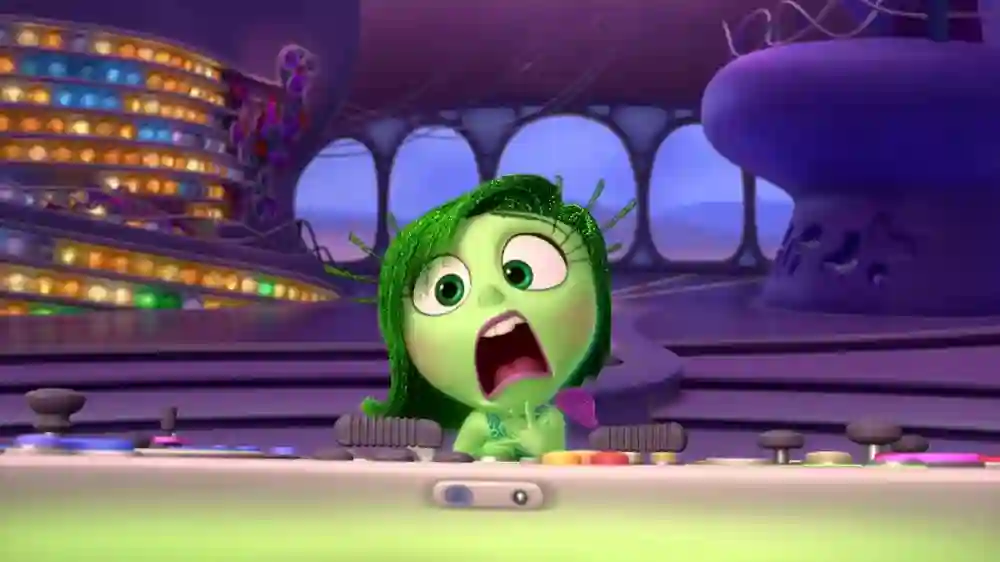Disgust Inside Out – The Essential Role of Disgust in Emotions

If you’ve ever watched Inside Out, you’ve probably laughed at Disgust’s green face and sassy attitude. I mean, who doesn’t love Mindy Kaling’s voice as an emotion that’s all about eye rolls and avoiding gross things? But here’s the kicker—Disgust Inside Out isn’t just there to make us giggle. It’s a crucial part of how we deal with the world, and believe it or not, it’s a lot more than just hating spoiled milk.
Anyway, I used to think disgust was all about “yuck” moments. You know, like the smell of gym socks after a long day or seeing someone’s lunch leftovers growing mold in the office fridge. But then I started to dig deeper, and I learned the hard way that disgust is way more complicated. It’s not just a reflex. It’s a survival tool. Go ahead and roll your eyes, but trust me on this one.
Disgust: Not Just a Gross-Out Emotion
Okay, let’s set the stage. I once tried to make a fancy dinner for my friends—big mistake. In my rush, I forgot to check the expiration date on the heavy cream. Fast forward past three failed attempts at salvaging the dish, and I was face-to-face with a blob of curdled chaos. My friends? Disgusted. Me? Mortified.
But that gut reaction, that disgust? It’s more than just “ugh”—it’s a protection mechanism. Turns out, Disgust Inside Out helps us avoid things that might harm us, like spoiled food, dirty surfaces, or, I don’t know, maybe a stranger’s questionable behavior. If we didn’t have disgust, we’d be chowing down on contaminated food without a second thought. And let’s be real—none of us want to be the person who’s that guy at a BBQ.
Psychologists call this the pathogen disgust type. It’s our body’s automatic “get away from that” signal. It’s why we’re repulsed by the idea of drinking spoiled milk or touching something slimy. It’s not about being picky, it’s about survival. So, yeah, next time you wrinkle your nose at a moldy sandwich, thank Disgust Inside Out for keeping your stomach and immune system intact.
The Science of Feeling Grossed Out
Let’s get nerdy for a minute. You know how when you feel disgusted, your stomach kind of flips, and maybe you even get that ugh in the back of your throat? That’s not just in your head. Disgust is hardwired into our brains. I mean, our insula (that’s a fancy word for a region in our brain) is practically throwing a party when we feel disgust. It lights up like a Christmas tree when you’re confronted with something gross, and yes, that includes the emotional stuff too.
Disgust Inside Out and the Brain
I used to think my brain was just a big mess of tangled wires, but nope, it’s way more organized than that. Disgust is processed in the same part of the brain that handles pain, hunger, and even your gut reactions (literally). So when you see a friend post a picture of their lunch and you’re like, “Nope, I’m good,” that’s your brain’s insula doing its job.
- Insula Cortex: This part gets active when you feel disgust, and let me tell you, it’s as busy as a beehive when you’re in an emotional reaction.
- Gut Reactions: Your brain and stomach are in cahoots—seriously. The reason your stomach does that flip when you see something revolting? Blame it on the vagus nerve, which is like your brain’s personal messenger.
So, next time you feel that rush of disgust, just remember: Your body is doing its job, making sure you’re not about to eat something that’ll make you sick.
Disgust Inside Out in Real Life
Here’s where things get a little deeper than just food and smells. Disgust isn’t just about rotten stuff—it’s woven into our social fabric. Ever had that one friend who can’t stop talking about how much they “hate” something? Yeah, that’s disgust at play, too. It’s not just physical. It’s moral. Social disgust is why we side-eye someone for bad behavior, or why we can’t stand the idea of a scam artist winning the lottery.
For me, it’s like when people cut in line at the grocery store. I can feel my blood pressure rising, and there’s this little disgust voice in my head going, “You’ve got to be kidding me.” Disgust isn’t just about protecting your health; it’s about maintaining your personal boundaries and, let’s be honest, your sanity.
Types of Disgust
Disgust shows up in more ways than you think. It’s not just limited to food or germs—it goes all the way to how we feel about other people, their actions, and sometimes, just the way they chew.
- Pathogen Disgust: The gross stuff—rotten food, sick people, dirty places.
- Moral Disgust: When someone violates the unspoken rules of society (cheating, dishonesty, etc.).
- Sexual Disgust: This one’s a little touchy, but it helps us navigate appropriate relationships and reproductive choices.
Fun fact: The Romans used to throw up after a feast so they could keep eating. Pretty sure that’s the opposite of what disgust is supposed to do, but hey, different strokes.
The Social Side of Disgust Inside Out
Here’s where it gets wild—Disgust Inside Out influences how we interact with others. It’s not just about whether something’s physically gross, but whether it aligns with our personal or cultural boundaries. Think about it: when you see someone acting in a way that feels “wrong” (cheating, breaking the rules), you feel disgust. It’s like your brain’s way of saying, “Nope. That’s not okay.”
And don’t get me started on how disgust shapes politics or religion. Seriously, people are often disgusted by things that challenge their beliefs. That’s how we form strong in-group vs. out-group thinking. Fun? Nope. Healthy? Sometimes, maybe. But it sure plays a role in shaping cultural norms.
The Dark Side of Disgust
And here’s where it gets a little tricky. While disgust is important for keeping us safe, it can also be harmful. Think about how disgust can fuel things like racism or homophobia. It can lead us to avoid or judge entire groups based on irrational fears. It’s like that time I judged the whole “green juice” trend. Who knew kale could be so judgmental? But seriously, disgust can get way out of hand, turning into prejudice or, worse, hate.
Disgust in Pop Culture
Okay, back to the fun stuff. Inside Out nailed it when they brought Disgust to life with Mindy Kaling’s voice. She’s sarcastic, stylish, and kind of hilarious—let’s be real, she’s the best. But that green face and side-eye? That’s not just comic relief. Disgust inside the movie represents so much of what we feel when something’s off.
If you’ve ever cringed at a bad movie or seen a fashion disaster on the red carpet, that’s your inner Disgust doing its thing. Pop culture loves a good villain, but Disgust? It’s the unsung hero of keeping us socially intact.
Disgust and Evolution: It’s All About Survival
Alright, let’s rewind the clock—way back. We didn’t have fancy tools or high-speed internet back in the day. What we did have was disgust. And it was basically like our built-in survival kit.
Our ancestors avoided rotten food and stayed away from things that looked… well, gross. Ever wondered why some people are allergic to shellfish? Evolution. We learned that some things could poison us. The idea of disgust in human evolution? Yeah, it was basically Mother Nature’s way of keeping us from eating bugs and dying from food poisoning.
Bullet Point: Evolutionary Functions of Disgust
- Pathogen avoidance: Avoiding contaminated food and water.
- Reproductive success: Not mating with someone carrying disease.
- Social cohesion: Keeping groups clean and cooperative.
Disgust Inside Out’s Influence on Our Boundaries
Here’s the thing—disgust helps us know our boundaries. It helps us decide what’s acceptable and what’s not. Whether it’s food or personal space, disgust sets limits.
And let’s be real—if we didn’t have disgust, who knows what would be happening on public transportation? It’s like that one time I got stuck next to someone who clearly hadn’t showered in a week—trust me, disgust helped me avoid that situation.
Managing Disgust: The Key to Mental Health
Not all disgust is helpful. If you’re like me, you’ve probably been grossed out by something that doesn’t really matter in the grand scheme of things (like an overripe banana). But here’s where things get tricky. If you let disgust control your life, it can lead to OCD, phobias, or even depression.
So yeah, don’t let that disgust spiral. Embrace it, understand it, but don’t let it run the show. Mindfulness, therapy, and the occasional Google search can help you keep it in check.
Wrapping It Up: Why Disgust Inside Out Is More Than Just “Yuck”
We can talk all day about how disgusting things are. But in the end, Disgust Inside Out is far more important than we give it credit for. It’s a survival tool, a moral compass, and a social glue. It keeps us healthy, safe, and, in some cases, makes sure we don’t hang out with people who chew loudly in public.





